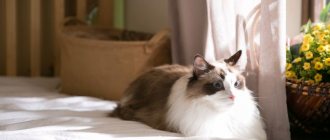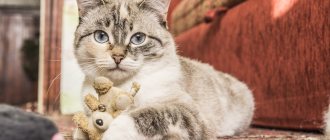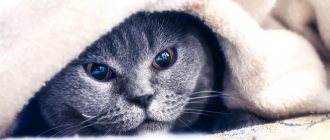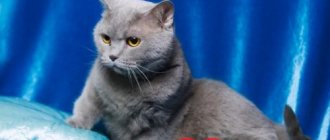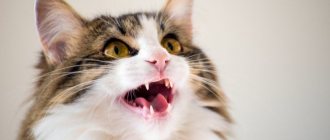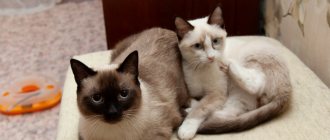Character and temperament
The British cat is a calm, balanced cat, which is characterized by purely English aristocracy.
She is sociable, affectionate and incredibly patient. A cat of the British breed quickly becomes attached to its owners and often meets them at the entrance, waiting for the right moment to sit comfortably on their laps. She has a sense of self-esteem, so she will not tolerate familiarity.
Breed and children
Attitude towards children is an important characteristic of cats of any breed. The British are patient with children and willingly play with them. But these aristocratic animals will never allow their own boundaries to be violated. And as soon as a child tries to pull a British cat’s tail, she will immediately hide in a secluded corner, and subsequently will avoid contact with the little “offender.”
Breed and other animals
Calm and sociable, Britons are friendly towards other cats, dogs and reptiles. Despite their developed hunting instincts, representatives of the breed do not harm ornamental rodents and birds living with them.
British character
Many stories have been written and told about the British cat. Only the British differ from other breeds in their independence and at the same time know how to combine this quality with love for their owner. They don’t like it when people “squeeze” them and show excessive affection towards their person. They tolerate loneliness and long separation from their owner very well, but they patiently wait for a meeting. Even if you want to hug your British cat when he doesn't want to, he will never scratch you or show aggression.
The British cat is a very loyal friend. He will get along well with a dog or other animal and will perceive them as his friends. Even playing with small, vocal children brings a lot of pleasure to the British. A huge number of people are united by their boundless love for this breed, proof of this is the existence of a British kitten nursery.
Habits
The bright character traits of the British directly influence their habits. Some people believe that since animals belonging to the presented breed are quite obedient, then they cannot do any bad things, but this is not so.
Common negative habits include:
- Scratching and biting hands.
- Throwing objects off surfaces.
To somehow compensate for this, many people want to know how the British are doing with catching mice, and this is a completely different matter.
Catching mice
British cats are often called clumsy. It is impossible to argue with this, but this does not prevent them from being excellent rat-catchers and mouse-catchers. If you believe history, the French always took cats of these breeds with them on voyages so that they would keep an eye on supplies and leave no chance for rodents to profit from various delicacies.
It is rare to find mice in modern apartments, so even with a strong desire, it would be difficult for cats to try to hunt someone. Another thing is animals that live in private sectors and in dachas. Pet owners have repeatedly noted that cats are very agile and excellent hunters. Some people believe that since they managed to cope with the rodent, they should definitely feast on it, but this is not so. Representatives of felines catch mice and rats for fun, they do not even understand that this is food that should be eaten. The reason lies in the character of the British cat, which was taught from childhood to a place for food. Having played enough, the animal leaves its prey and goes on about its business.
Biting and scratching
Scratching and biting the hands of their owners is a favorite activity of four-legged animals. At the age of three or four months, the kitten begins to bite the hands and sometimes the legs of a person. This is directly related to the change of teeth in animals. There is no need to think that such a habit will go away on its own. If the situation continues for a month, the animal will realize that it is possible to do this and in the future you will not wean it from it. At the same time, there is no need to try to beat the baby or shout at him; it is not his fault that his teeth itch. It needs to be done much simpler - during an attack, put a soft toy or mouse on your hand, which will interest the pet and become its favorite victim in the future.
Dropping items
Throwing objects off the table is an equally interesting activity. It can be anything, from a pen to a flower pot. Among the main character traits, self-indulgence is not listed among the British, but for them it is not self-indulgence, but curiosity. Cats are very interested to see how the object will fly down and what will happen to it after. If you want to stop this, then you should either sprinkle the surface with a pungent odor that animals cannot tolerate, or make the surface so that the pet does not have the slightest chance of climbing on it. At the same time, you must not forget about toys for your pet so that he does not have to get bored.
Description of British shorthair cats
A characteristic feature of the description of these cats is the fairly frequent use of the word “round”. It is this feature that largely characterizes the appearance of British cats with short hair. The British have a lot in common with the Scottish branch of cats, however, there are also many differences.
Body
Case sizes range from medium to large. The animals are well built: straight, strong back, wide chest, strong muscles. They reach their maximum size at the age of four years. Moreover, males weigh noticeably more than females.
Limbs
The cat's paws have a length proportional to the body. This feature persists in adults. The fore and hind legs are medium in size and very strong. The paw pads are round and strong. There are five fingers on the front ones, only four on the back ones.
Tail
This part of the breed's body is proportional to the body and has an average length. The tail is thick at the base, gradually tapers towards the tip and ends roundly.
Head
British Shorthairs are characterized by a regular, rounded and fairly massive skull. This shape is emphasized by a slightly sloping forehead and a flattened crown. The outline of the muzzle also has the shape of a circle. The whisker pads are round and convex. Wide, medium sized nose. If you look at the cat in profile, you can see a slight bend. The nose, together with the upper lip and chin, forms a vertical line. The chin itself is quite strong.
Ears
The ears of cats are set wide apart and are of medium size. The relatively wide base of the ears and rounded tips do not interfere with the overall round shape of the head.
Eyes
The breed is characterized by wide-set, round eyes. The open gaze of large eyes gives cats an attentive and slightly surprised expression. The iris palette includes orange, gold, copper, blue, lavender, green.
Wool
The British Shorthair's coat is their pride. Short and thick hair has a characteristic, pleasant shine. Cats that have long or downy hair are disqualified from being purebred cats.
Pets' fur is always soft and elastic to the touch. This is explained not only by the structure of the hair, but also by the nature of the entire coat. Cats have a thick undercoat equal in length to the center hair. In this case, the hairs do not fit tightly to the body. The short, plush coat makes the British kitten look like a toy.
British Shorthair colors
The standard allows for more than thirty colors of wool. The British Shorthair cat can have either a single color or a multi-colored one. In the first case, all hairs are dyed evenly in one color. At the same time, shaded, smoky and slight shimmer is allowed in cats.
The most popular colors are:
| white black blue cream | gray brown red fawn | red chocolate color-point lilac | silver blue gold cinnamon silver |
All possible combinations of short coat color types are allowed.
- tabby mackerel
- brindle
- tortoiseshells
- marble
- bicolor
- smoky
- ticked
- chinchilla
Shorthaired British Chinchillas are precious colors and are highly prized.
Despite such an abundance of colors and combinations, CFA does not allow chocolate color in color.
Other felinological organizations (GCCF and TICA) do not cull individuals with this coat color. At the same time, all experts agree that spots and medallions in the appearance of animals are a disqualifying sign.
Peculiarities of behavior of British cats
The British are approachable and sociable, friendly and affectionate. They get along well with all family members, and they simply love their mistress or owner selflessly. The cat may follow you from room to room until you sit down and allow it to sit next to you.
Possessing an inexhaustible supply of patience, British Shorthairs are very fond of children and get along well with other animals, incl. and with dogs. But still, you shouldn’t have a Briton as a children’s toy. Despite the reverent display of love and tenderness towards its owners, this cat will not tolerate too familiar an attitude towards itself.
In relationships with people, the British maintain independence, which does not allow you to completely become the master, rather the opposite. They do only what they consider necessary. Their attitude towards the world around them can be characterized as follows: the British have a great attitude only towards those people who love them, and get along only with those animals that do not annoy them with their intolerable presence.
Thanks to their independent nature and low-maintenance coat, British Shorthairs are ideal for people who spend a lot of time at work. It is no coincidence that these animals are called “cats for businessmen.”
Despite the fact that the British cat is surprisingly similar to a teddy bear, you should not treat it like a toy. She patiently allows you to do everything to her that does not humiliate her cat's dignity, but if she is offended, she can show sharp claws, which for the time being are hidden in her round paws. With all this, the British are absolutely unfamiliar with causeless aggression and deceit.
Brits don't like to climb on their laps, probably because their plush coats make them overheat. If you persuade a cat, she will, of course, agree to give you pleasure and sit on your lap for a few minutes, but if you try to force her, she will definitely run away.
Unlike other cat breeds, British Shorthairs are virtually impossible to train. Raising a Briton is not at all necessary. The cat is smart enough and can figure everything out on its own. Even a tiny kitten will not go to the toilet in a place not designated for this purpose or sharpen its claws on pieces of furniture if you have shown it where the scratching post is.
The British don't like to be hugged or carried around like children. They are happy to be close to their owner, following him everywhere. Being held in your arms, cats feel dependent and controlled, which is contrary to their feline dignity, and in addition, these large and heavy animals become very uncomfortable without solid support under their feet.
The Briton is a symbol of calm, restraint and homeliness. This cat prefers to be in a quiet abode. She herself also does not make loud sounds; she meows very rarely, quietly and only in case of emergency.
British Shorthairs go to sleep in the most unimaginable places. The cat's sleeping place should be located at some elevation, away from drafts. British cats do not suffer from insomnia, although there are periods of greater or less sleepiness in their lives.
Cats are natural born cleaners, and the British are no exception. The cat spends almost half of its active time on toileting. Licking and washing is not only a hygienic procedure. The cat also uses them to achieve psychological comfort, for example, after stress, a visit to the veterinarian, traveling on public transport, etc.
It should be noted that British Shorthair cats are very sensitive to the psychological situation in the house. If it is unfavorable and the owners often quarrel and make noise, this nervousness is transmitted to the animals, who have an irresistible desire to wash themselves.
British Shorthair cats are active and playful, but their play is not destructive. They adapt perfectly to any size room, so neighbors downstairs won't complain about overhead noise.
For many reasons, the British can be called an ideal cat: a kind look, a pleasant character, a wide range of colors, a solid and presentable appearance, a sense of self-esteem literally radiated by the animal, ease of care and a calm temperament - all these features of the breed have ensured its rapid rise in popularity in countries around the world and in our country as well.
Yorkshire Terrier puppy and cat...
Many cat owners decide to buy a puppy in the future, but doubt arises how these “enemies” will get along in your home.
Meanwhile, millions of people live with at least one dog and one cat. How do they do it? If a puppy and a kitten live and grow together from childhood, they have a better chance of growing up as a friendly company. But many people want to buy a puppy, already having an adult cat, this is quite possible. It is very important to choose a breed that can get along with your favorite cat; this choice must be taken very seriously. The Yorkshire Terrier is ideal due to its small size and calm nature. In order for your cat to accept a Yorkie puppy into her family, there are some basic steps you need to take to achieve friendly pets.
In the photo is our girl Yorkshire Terrier Lux Mia Eva Garden and her new friend. She ended up in a wonderful home, where an adult cat had already lived before her.
They have a truly wonderful cat-dog relationship. In the photo, this friendly company sleeps and plays together, there are, of course, small disagreements, but then there is reconciliation. Photos courtesy of Evochka’s owner Alla K. Here are some practical tips:
• The first days of a puppy’s stay in a new home are of course stressful, the little Yorkie gradually gets used to new smells, sniffing the new territory, so for the first days, keep the puppy separate from the cat. You need to let the puppy smell the place where the cat sleeps and vice versa, so I gradually accustom them to each other’s smell. This time is a great opportunity to reinforce your dog's basic obedience training.
• When interacting with the puppy, do not forget to pay attention to the cat so that your pet does not develop a feeling of jealousy.
• When the Yorkshire Terrier puppy gets comfortable in the new territory, gets used to his bed and the room where he now lives, you can begin the baby’s first meeting with the cat. Acquaintance should begin in your presence. First, we bring the puppy to the cat from the side of the muzzle in our arms, giving the new friends the opportunity to sniff each other. • While the Yorkie puppy is growing, we try not to leave him alone with the cat at first, even if your cat has a good, calm character. The Yorkshire Terrier is very inquisitive and loves to play, he may perceive the cat's tail as a new toy and try to catch it, but you must understand that not every cat will accept the conditions of the game. If the cat suddenly turns around and hits the baby with its paw, the puppy may be injured. • Never leave a cat and puppy together until you are sure they get along. Your cat should be able to refuse to interact with the puppy, if she wants privacy and feels safe looking at the puppy from her house, then so be it.
Bad habits
The breed is distinguished by aristocratic manners, but even it is characterized by some bad habits:
- Kittens can bite during the period when baby teeth are replaced by permanent ones (from 4 to 6-7 months). To prevent this from becoming a habit, the baby is immediately offered to sharpen his teeth with the help of toys, and not the owner’s hands.
- Many British cats love to knock various objects off shelves and chase them across the floor. Therefore, it is better to put figurines, pens, tubes of creams, vases and other things away, and treat the favorite place with a repellent spray. The drug can be purchased at a pet store or veterinary pharmacy.
- The British are inquisitive - they will not refuse to check a bag, reach into a package or rummage through things. If the owner does not like these habits, it is better to put all the “interesting things” out of reach.
Bad habits often arise from boredom or lack of attention. If the cause is eliminated, the British cat will quickly get rid of them.
Why do dogs and cats fight?
The main factors provoking hostility are:
- Territory. It is important to provide not only a separate place for both animals to sleep, but also for feeding, toileting, and playing.
- Food. The issue of nutrition most often causes jealousy. You need to feed your pets at the same time, so as not to cause envy, but in different places. They should not be allowed to eat from the same utensils.
- Attention. If one pet is still small, it requires more time for care. Then you need to increase your time with the other one so that he doesn’t get jealous.
- Personal items. Toys, combs, hygiene items must be individual. If a dog smells a cat on its brush, it will cause jealousy and aggression.
A good way to make friends with animals is to send them for a walk together in the yard of a private house or country house. Usually on the street they quickly find common interests.
To make friends between a cat and a dog, the owner needs to be determined to devote equal amounts of time and energy to both of them. It is important to prepare in advance by arranging a place for them in the house or apartment. The issue of territory, food, and personal belongings deserve special attention; it is important to prevent envy or jealousy of one of the pets.
History of the breed
The British Shorthair itself dates back to the 19th century, but the roots of the breed go back far, to the beginning of our era. It was then that the Romans waged wars of conquest in Europe, including in England, where they brought cats from the continent. But those cats were outwardly far from modern British ones. And only many centuries later, crossing with other breeds in the climatic conditions of Foggy Albion, they acquired the characteristic qualities of the breed known to us.
It was only in the 19th century that cat lovers began to notice the beauty and strength of the British. A well-known popularizer of them was Harrison Weyer, a great connoisseur of cats. It was he who held the first cat show in London in 1871, at which many breeds were presented, but the star was the British Shorthair cat. Further popularity began to grow like a snowball; owning this cat was considered status in many English homes.
At the beginning of the 20th century, the British lost in popularity to Persian and Abyssinian cats. It was only after World War II that the breed again began to attract the interest of breeders.
Over time, the British breed spread and gained incredible popularity throughout Europe and the USA. In 2020, these cats were in 3rd place in the world in popularity among all breeds registered by the CFA (Cat Fanciers' Association).
This is interesting: Top smartest cat breeds
Related materials
00:02 — November 11, 2016
Be careful, the ridge is rising!
A forgotten and dangerous “weapon” was found in Hitler’s possession.
There is a lot of documentary evidence of how the war affected people and domestic animals. Examples include about a million cows, pigs and laying hens slaughtered in Denmark due to a lack of imported feed; the sounds of the slaughter of cattle left behind by refugees heard by the Germans entering Paris on June 14, 1940.
It is interesting to consider the British attitude towards animals in the context of the mythologization of the war of 1939-1945. In Great Britain, it is often called a “people's war”, and the country's citizens are shown exclusively on the positive side.
What happened in September 1939? It is important to understand that not a single bomb fell on British soil until April 1940. The British government did not make decisions about the need to euthanize pets - citizens themselves carried their pets to slaughter.
On September 7, 1939, the Times reported that thousands of cats and dogs were being destroyed in veterinary centers and that people were bringing in even more every day. The Royal Society for the Prevention of Cruelty to Animals (RPSCA) has been forced to double the staff at its clinics and hire night shift staff.
